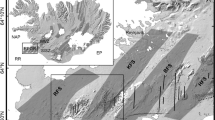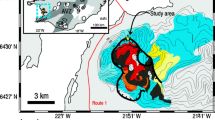Abstract
A three-dimensional model has been used to estimate the location and dimensions of the eruptive fissure for the 24–29 September 1971 eruption along the southwest rift zone of Kilauea volcano, Hawaii. The model is an inclined rectangular sheet embedded in an elastic half-space with constant displacement on the plane of the sheet. The set of “best” model parameters suggests that the sheet is vertical, extends from a depth of about 2 km to the surface, and has a length of about 14 km. Because this sheet intersects the surface where eruptive vents and extensive ground cracking formed during the eruption, this sheet probably represents the conduit for erupted lava. The amount of displacement perpendicular to the sheet is about 1.9 m, in the middle range of values measured for the amount of opening across the September 1971 eruptive fissure. The thickness of the eruptive fissure associated with the January 1983 east rift zone eruption was determined in an earlier paper to be 3.6 m, about twice the thickness determined here for the September 1971 eruption. Because the lengths (12 km for 1983 and 14 km for 1971) and heights (about 2 km) of the sheet models derived for the January 1983 and September 1971 rift zone eruptions are nearly identical, the greater thickness for the January 1983 eruptive fissure implies that the magma pressure was about a factor of two greater to form the January 1983 eruptive fissure. Because the September 1971 and January 1983 eruptive fissures extent to depths of only a few kilometers, the region of greatest compressive stress produced along the volcano's flank by either of these eruptive fissures would also be within a few kilometers of the surface. Previous work has shown that rift eruptions and intrusions contribute to the buildup of compressive stress along Kilauea's south flank and that this buildup is released by increased seismicity along the south flank. Because south flank earthquakes occur at significantly greater depths, i.e., from 5 to 13 km, than the vertical extent of the 1971 and 1983 eruptiv fissures, the depth of emplacement of these eruptive fissures cannot be the main factor in controlling the hypocentral depths of south flank earthquakes. Two possible explanations for the occurrence of south flank earthquakes in the depth range of 5–13 km are (1) a deeper pressure source, possibly related to deeper magma storage within the rift zone, and (2) a lowstrength region located between 5 and 13 km beneath Kilauea's south flank, possibly at the interface between oceanic sediments and the base of the Hawaiian volcanics.
Similar content being viewed by others
References
Casadevall TJ, Dzurisin D (1987) Intrusive rocks of Kilauea caldera. In: Decker RW, Wright TL, Stauffer PH (eds) US Geol Survey Prof Pap 1350, Volcanism in Hawaii, vol 1:377–394
Davis PM (1983) Surface deformation associated with a dipping hydrofracture. J Geophys Res 88:5826–5834
Dieterich JH, Decker RW (1975) Finite element modeling of surface deformation associated with volcanism. J Geophys Res 80:4094–4102
Duffield WA, Christiansen RL, Koyangi RY, Peterson DW (1982) Storage, migration, and eruption of magma at Kilauea Volcano, Hawaii, 1971–1972. J Volc Geotherm Res 13:273–307
Dvorak J, Okamura A (1985) Variations in tilt rate and harmonic tremor amplitude during the January-August 1983 east rift eruptions of Kilauea Volcano, Hawaii. J Volc Geotherm Res 25:249–258
Dvorak J, Okamura A (1987) A hydraulic model to explain variations in summit tilt rate of Kilauea and Mauna Loa Volcanoes. In: Decker RW, Wright TL, Stauffer PH (eds) US Geol Survey Prof Pap 1350, Volcanism in Hawaii, vol 2:1281–1296
Dvorak J, Okamura A, Dieterich JH (1983) Analysis of surface deformation data, Kilauea Volcano, Hawaii: October 1966 to September 1970. J Geophys Res 88:9295–9304
Dvorak J, Okamura A, English TT, Koyanagi RY, Nakata JS, Sako MK, Tanigawa WT, Yamashita KM (1985) Mechanical response of the south flank of Kilauea Volcano, Hawaii, to intrusive events along the rift systems. Tecnophysics 124:193–209
Dzurisin D, Koyanagi RY, English TT (1984) Magma supply and storage at Kilauea Volcano, Hawaii: 1956–1983. J Volc Geotherm Res 21:177–206
Eaton JP (1962) Crustal structure and volcanism in Hawaii. Am Geophys Union Monograph 6:13–29
Eaton JP, Murata KJ (1960) How volcanoes work, Science 132:925–938
Fiske RS, Kinoshita WT (1969) Inflation of Kilauea Volcano prior to the 1967–68 eruption. Science 165:341–349
Furumoto AS, Kovach RL (1979) The Kalapana earthquake of November 29, 1975: an intraplate earthquake and its relation to geothermal processes. Phys Earth Planet Int 18:373–396
Jackson DB, Swanson DA, Koyanagi RY, Wright TL (1975) The August and October 1968 east rift eruptions of Kilauea Volcano, Hawaii. US Geol Survey Prof Pap 890
Kinoshita WT, Swanson DA, Jackson DB (1974) The measurement of crustal deformation related to volcanic activity at Kilauea Volcano, Hawaii. In: Civetta L, Gasparini P, Luongo G, Rapolla A (eds) Physical volcanology. Elsevier, Amsterdam, pp 87–115
Klein FW, Koyanagi RY, Nakata JS, Tanigawa WR (1987) The seismicity of Kilauea's magma system. In: Decker RW, Wright TL, Stauffer PH (eds) US Geol Survey Prof Pap 1350, Volcanism in Hawaii, vol 2:1019–1185
Nakamura K (1980) Why do long rift zones develop in Hawaiian volcanoes — a possible role of thick ocean sediments. Bull Volc Soc Japan 25:255–267
Okada Y (1985) Surface deformation due to shear and tensile faults in a half-space. Bull Seism Soc Am 75:1135–1154
Pollard DD, Holzhausen G (1979) On the mechanical interaction between a fluid-filled fracture and the earth's surface. Tectonophysics 53:27–57
Pollard DD, Muller OH (1976) The effect of gradients in regional stress and magma pressure on the form of sheet intrusions in cross section. J Geophys Res 81:975–984
Pollard DD, Delaney PT, Duffield WA, Endo ET, Okamura AT (1983) Surface deformation in volcanic rift zones. Tectonophysics 94:541–584
Rubin AM, Pollard DD (1988) Dike-induced faulting in rift zones of Iceland and Afar. Geology 16:413–417
Ryan MP, Blevins JYK, Okamura AT, Koyanagi RY (1983) Magma reservoir subsidence mechanics, theoretical summary, and application to Kilauea volcano, Hawaii. J Geophys Res 88:4147–4201
Swanson DA, Jackson DB, Koyanagi TY, Wright TL (1976a) The February 1969 east rift eruption of Kilauea Volcano, Hawaii. US Geol Survey Prof Pap 891
Swanson DA, Duffield WA, Fiske RS (1976b) Displacement of the south flank of Kilauea Volcano: the result of forceful intrusion of magma into the rift zones. US Geol Survey Prof Pap 963
Wright TL, Fiske RS (1971) Origin of the differentiated and hybrid lavas of Kilauea Volcano, Hawaii. J Petrol 12:1–65
Author information
Authors and Affiliations
Rights and permissions
About this article
Cite this article
Dvorak, J.J. Geometry of the September 1971 eruptive fissure at Kilauea volcano, Hawaii. Bull Volcanol 52, 507–514 (1990). https://doi.org/10.1007/BF00301531
Received:
Accepted:
Issue Date:
DOI: https://doi.org/10.1007/BF00301531




